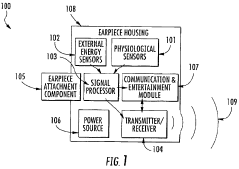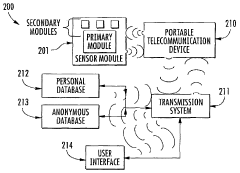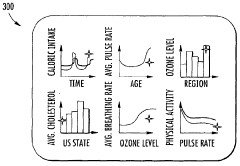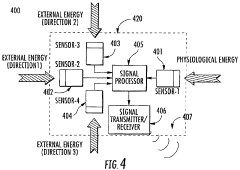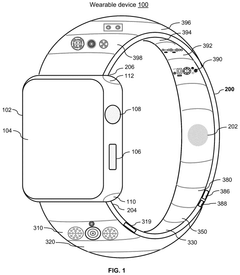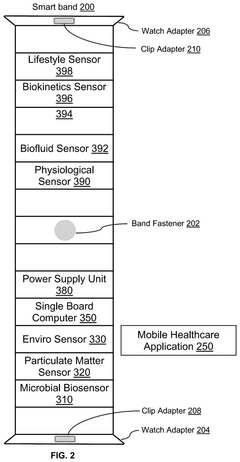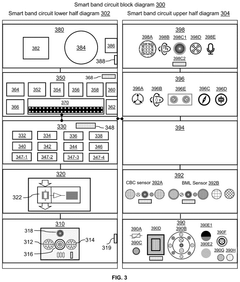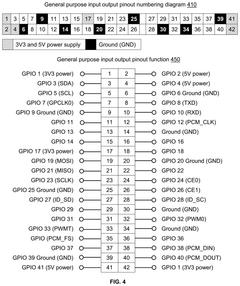Wearable Biosensors in Environmental Monitoring Applications
OCT 24, 202510 MIN READ
Generate Your Research Report Instantly with AI Agent
Patsnap Eureka helps you evaluate technical feasibility & market potential.
Wearable Biosensor Evolution and Environmental Monitoring Goals
Wearable biosensors have undergone significant evolution over the past two decades, transforming from bulky, limited-function devices to sophisticated, miniaturized systems capable of continuous monitoring. The first generation of wearable biosensors emerged in the early 2000s, primarily focusing on basic physiological parameters such as heart rate and step counting. These devices were characterized by limited battery life, minimal data processing capabilities, and restricted connectivity options.
By the mid-2010s, the second generation of wearable biosensors incorporated advanced sensing technologies, improved power management systems, and enhanced wireless communication protocols. This evolution enabled more comprehensive health monitoring applications, including sleep tracking, stress assessment, and basic environmental exposure detection. The integration of microelectromechanical systems (MEMS) and flexible electronics significantly improved user comfort and adoption rates.
The current generation of wearable biosensors represents a paradigm shift in capabilities, featuring multimodal sensing arrays, edge computing capabilities, and AI-driven analytics. These advancements have expanded the application scope beyond personal health monitoring to include environmental surveillance, creating new opportunities for real-time detection of environmental hazards and pollutants.
In the environmental monitoring domain, wearable biosensors aim to address several critical challenges. Primarily, they seek to enable continuous, real-time monitoring of environmental parameters that affect human health, including air quality indicators (particulate matter, volatile organic compounds, ozone), water contaminants, radiation levels, and noise pollution. This represents a significant improvement over traditional environmental monitoring approaches that rely on stationary equipment and periodic sampling.
Another key objective is to establish correlations between environmental exposures and physiological responses at the individual level. By simultaneously tracking environmental parameters and biological markers, these devices can provide personalized insights into how specific environmental factors impact individual health outcomes, supporting precision environmental health initiatives.
From a public health perspective, wearable biosensors aim to democratize environmental monitoring by creating distributed sensor networks through citizen participation. This approach enables high-resolution spatial and temporal mapping of environmental conditions across diverse geographic areas, potentially transforming environmental epidemiology and policy development.
The technological goals include developing sensors with enhanced sensitivity and selectivity for environmental analytes, improving energy efficiency to support long-term deployment, and creating robust data integration frameworks that can synthesize information from multiple sensor types and sources. Additionally, there is a focus on developing biocompatible materials and form factors that ensure user comfort during extended wear periods while maintaining measurement accuracy.
By the mid-2010s, the second generation of wearable biosensors incorporated advanced sensing technologies, improved power management systems, and enhanced wireless communication protocols. This evolution enabled more comprehensive health monitoring applications, including sleep tracking, stress assessment, and basic environmental exposure detection. The integration of microelectromechanical systems (MEMS) and flexible electronics significantly improved user comfort and adoption rates.
The current generation of wearable biosensors represents a paradigm shift in capabilities, featuring multimodal sensing arrays, edge computing capabilities, and AI-driven analytics. These advancements have expanded the application scope beyond personal health monitoring to include environmental surveillance, creating new opportunities for real-time detection of environmental hazards and pollutants.
In the environmental monitoring domain, wearable biosensors aim to address several critical challenges. Primarily, they seek to enable continuous, real-time monitoring of environmental parameters that affect human health, including air quality indicators (particulate matter, volatile organic compounds, ozone), water contaminants, radiation levels, and noise pollution. This represents a significant improvement over traditional environmental monitoring approaches that rely on stationary equipment and periodic sampling.
Another key objective is to establish correlations between environmental exposures and physiological responses at the individual level. By simultaneously tracking environmental parameters and biological markers, these devices can provide personalized insights into how specific environmental factors impact individual health outcomes, supporting precision environmental health initiatives.
From a public health perspective, wearable biosensors aim to democratize environmental monitoring by creating distributed sensor networks through citizen participation. This approach enables high-resolution spatial and temporal mapping of environmental conditions across diverse geographic areas, potentially transforming environmental epidemiology and policy development.
The technological goals include developing sensors with enhanced sensitivity and selectivity for environmental analytes, improving energy efficiency to support long-term deployment, and creating robust data integration frameworks that can synthesize information from multiple sensor types and sources. Additionally, there is a focus on developing biocompatible materials and form factors that ensure user comfort during extended wear periods while maintaining measurement accuracy.
Market Analysis for Environmental Monitoring Wearables
The global market for environmental monitoring wearables is experiencing significant growth, driven by increasing environmental concerns and technological advancements in biosensor capabilities. Current market valuations indicate that the environmental monitoring sector, including wearable technologies, reached approximately 14 billion USD in 2022 and is projected to grow at a compound annual growth rate of 7.5% through 2028. Wearable biosensors specifically designed for environmental monitoring represent an emerging segment within this broader market.
Consumer demand for personal environmental monitoring has risen substantially, particularly in regions with high pollution levels such as East Asia, South Asia, and urban centers worldwide. Market research indicates that approximately 65% of urban consumers in developed economies express interest in devices that can monitor air quality, UV exposure, and potential toxin exposure in their immediate environment. This represents a substantial shift from previous years when environmental monitoring was primarily the domain of governmental and research institutions.
The industrial sector presents another significant market opportunity, with industries such as mining, chemical manufacturing, and agriculture showing increased adoption of wearable monitoring solutions for worker safety and environmental compliance. The market for industrial environmental wearables is expected to grow by 9.3% annually through 2027, outpacing the consumer segment.
Healthcare applications represent a third major market segment, with medical professionals increasingly recognizing the value of continuous environmental exposure data in patient care. Hospitals and clinics are beginning to incorporate environmental exposure data from wearables into patient records, creating a new market estimated at 2.1 billion USD by 2025.
Regional analysis reveals that North America currently leads the market with approximately 38% market share, followed by Europe (29%) and Asia-Pacific (24%). However, the Asia-Pacific region is expected to demonstrate the fastest growth rate in the coming years due to increasing environmental regulations, rising consumer awareness, and expanding industrial sectors in countries like China and India.
Market barriers include concerns about data privacy, accuracy of measurements, device durability in harsh environments, and integration challenges with existing environmental monitoring systems. Price sensitivity remains high, particularly in consumer markets, with research indicating that widespread adoption would require retail prices below 150 USD for basic environmental monitoring wearables.
Emerging opportunities include integration with smart city initiatives, subscription-based environmental data services, and specialized applications for vulnerable populations such as children, elderly, and individuals with respiratory conditions. The convergence of environmental monitoring with health tracking represents a particularly promising market direction, with potential to expand the total addressable market by an estimated 40% by 2030.
Consumer demand for personal environmental monitoring has risen substantially, particularly in regions with high pollution levels such as East Asia, South Asia, and urban centers worldwide. Market research indicates that approximately 65% of urban consumers in developed economies express interest in devices that can monitor air quality, UV exposure, and potential toxin exposure in their immediate environment. This represents a substantial shift from previous years when environmental monitoring was primarily the domain of governmental and research institutions.
The industrial sector presents another significant market opportunity, with industries such as mining, chemical manufacturing, and agriculture showing increased adoption of wearable monitoring solutions for worker safety and environmental compliance. The market for industrial environmental wearables is expected to grow by 9.3% annually through 2027, outpacing the consumer segment.
Healthcare applications represent a third major market segment, with medical professionals increasingly recognizing the value of continuous environmental exposure data in patient care. Hospitals and clinics are beginning to incorporate environmental exposure data from wearables into patient records, creating a new market estimated at 2.1 billion USD by 2025.
Regional analysis reveals that North America currently leads the market with approximately 38% market share, followed by Europe (29%) and Asia-Pacific (24%). However, the Asia-Pacific region is expected to demonstrate the fastest growth rate in the coming years due to increasing environmental regulations, rising consumer awareness, and expanding industrial sectors in countries like China and India.
Market barriers include concerns about data privacy, accuracy of measurements, device durability in harsh environments, and integration challenges with existing environmental monitoring systems. Price sensitivity remains high, particularly in consumer markets, with research indicating that widespread adoption would require retail prices below 150 USD for basic environmental monitoring wearables.
Emerging opportunities include integration with smart city initiatives, subscription-based environmental data services, and specialized applications for vulnerable populations such as children, elderly, and individuals with respiratory conditions. The convergence of environmental monitoring with health tracking represents a particularly promising market direction, with potential to expand the total addressable market by an estimated 40% by 2030.
Current Biosensor Technologies and Environmental Detection Challenges
The current landscape of biosensor technologies for environmental monitoring presents a complex interplay of advancements and limitations. Electrochemical biosensors dominate the field due to their high sensitivity, rapid response times, and relatively low cost. These sensors typically utilize enzymes, antibodies, or nucleic acids as recognition elements to detect specific environmental contaminants, converting biological responses into measurable electrical signals. Optical biosensors, particularly those employing fluorescence and surface plasmon resonance techniques, have gained significant traction for their ability to provide real-time, label-free detection of environmental pollutants with minimal sample preparation.
Despite these technological advances, wearable biosensors face substantial challenges in environmental monitoring applications. Sensor stability remains a primary concern, as exposure to varying environmental conditions—including temperature fluctuations, humidity, and UV radiation—can significantly degrade biosensor performance over time. The recognition elements, especially enzymes and antibodies, are particularly susceptible to denaturation in harsh environmental conditions, limiting their operational lifespan and reliability in field applications.
Selectivity presents another critical challenge, as environmental samples typically contain complex mixtures of compounds that can interfere with target analyte detection. Cross-reactivity with non-target molecules frequently leads to false positive results, undermining the reliability of biosensor data. This issue becomes particularly pronounced when monitoring trace contaminants in complex environmental matrices such as soil, water, or air.
Power management constitutes a significant hurdle for wearable environmental biosensors. Continuous monitoring applications demand efficient energy utilization, yet many current biosensor designs require frequent recharging or battery replacement, limiting their practical deployment in remote environmental monitoring scenarios. The trade-off between power consumption and sensor performance often forces compromises in sampling frequency and data transmission capabilities.
Data interpretation and validation represent additional challenges in the environmental biosensor domain. Converting raw sensor signals into meaningful environmental health indicators requires sophisticated algorithms and reference standards. The lack of standardized calibration protocols across different environmental matrices complicates data comparison and integration into broader environmental monitoring networks.
Miniaturization while maintaining sensitivity presents ongoing engineering challenges. Current wearable biosensor platforms often struggle to achieve the detection limits necessary for environmental contaminants that are harmful at extremely low concentrations, such as certain pesticides, heavy metals, and emerging pollutants. The physical constraints of wearable formats limit the implementation of sample pre-concentration or purification steps that are standard in laboratory-based detection methods.
Despite these technological advances, wearable biosensors face substantial challenges in environmental monitoring applications. Sensor stability remains a primary concern, as exposure to varying environmental conditions—including temperature fluctuations, humidity, and UV radiation—can significantly degrade biosensor performance over time. The recognition elements, especially enzymes and antibodies, are particularly susceptible to denaturation in harsh environmental conditions, limiting their operational lifespan and reliability in field applications.
Selectivity presents another critical challenge, as environmental samples typically contain complex mixtures of compounds that can interfere with target analyte detection. Cross-reactivity with non-target molecules frequently leads to false positive results, undermining the reliability of biosensor data. This issue becomes particularly pronounced when monitoring trace contaminants in complex environmental matrices such as soil, water, or air.
Power management constitutes a significant hurdle for wearable environmental biosensors. Continuous monitoring applications demand efficient energy utilization, yet many current biosensor designs require frequent recharging or battery replacement, limiting their practical deployment in remote environmental monitoring scenarios. The trade-off between power consumption and sensor performance often forces compromises in sampling frequency and data transmission capabilities.
Data interpretation and validation represent additional challenges in the environmental biosensor domain. Converting raw sensor signals into meaningful environmental health indicators requires sophisticated algorithms and reference standards. The lack of standardized calibration protocols across different environmental matrices complicates data comparison and integration into broader environmental monitoring networks.
Miniaturization while maintaining sensitivity presents ongoing engineering challenges. Current wearable biosensor platforms often struggle to achieve the detection limits necessary for environmental contaminants that are harmful at extremely low concentrations, such as certain pesticides, heavy metals, and emerging pollutants. The physical constraints of wearable formats limit the implementation of sample pre-concentration or purification steps that are standard in laboratory-based detection methods.
Existing Wearable Solutions for Environmental Parameter Detection
01 Wearable biosensors for health monitoring
Wearable biosensors designed for continuous health monitoring can track various physiological parameters such as heart rate, blood pressure, body temperature, and glucose levels. These devices enable real-time health tracking and early detection of abnormalities, allowing for timely medical intervention. The sensors are typically integrated into comfortable wearable formats like patches, wristbands, or clothing to facilitate long-term use while maintaining accuracy in data collection.- Wearable biosensors for health monitoring: Wearable biosensors designed for continuous health monitoring can track various physiological parameters such as heart rate, blood pressure, body temperature, and glucose levels. These devices enable real-time health data collection and analysis, allowing for early detection of health issues and personalized healthcare management. The sensors can be integrated into everyday wearable items like watches, patches, or clothing for non-invasive monitoring.
- Sweat-based biosensing technologies: Biosensors that analyze sweat composition can detect various biomarkers including electrolytes, metabolites, and hormones without invasive procedures. These sensors utilize electrochemical, optical, or colorimetric detection methods to measure analytes in sweat. The technology enables continuous monitoring of physiological status during physical activity and can be incorporated into flexible, skin-adherent patches or wristbands for comfortable wear during daily activities.
- Implantable and minimally invasive biosensors: Minimally invasive and implantable biosensors offer continuous monitoring of internal physiological parameters that cannot be easily measured from the skin surface. These sensors can be inserted subcutaneously or implanted within specific tissues to monitor glucose levels, drug concentrations, or disease biomarkers. Advanced materials and biocompatible coatings help reduce foreign body responses and extend the functional lifetime of these sensors while maintaining measurement accuracy.
- Flexible and stretchable biosensor platforms: Flexible and stretchable electronic platforms enable biosensors to conform to the body's contours and maintain functionality during movement. These platforms utilize advanced materials such as conductive polymers, nanomaterials, and thin-film electronics to create sensors that can bend, stretch, and twist without performance degradation. The technology allows for improved comfort, better skin contact, and more reliable measurements in dynamic environments, making them suitable for continuous wear during daily activities.
- Data processing and connectivity for wearable biosensors: Advanced data processing systems and connectivity solutions enhance the functionality of wearable biosensors by enabling real-time analysis, storage, and transmission of health data. These systems incorporate machine learning algorithms to identify patterns and anomalies in physiological measurements, providing actionable insights to users and healthcare providers. Wireless connectivity technologies allow for seamless integration with smartphones, cloud platforms, and healthcare information systems, facilitating remote monitoring and telemedicine applications.
02 Sweat-based biosensing technologies
Sweat-based biosensors analyze biomarkers present in perspiration to provide non-invasive monitoring of various health indicators. These sensors can detect electrolytes, metabolites, hormones, and other biomolecules in sweat, offering insights into hydration status, stress levels, and metabolic conditions. The technology typically employs electrochemical, optical, or colorimetric detection methods integrated into flexible, skin-adherent platforms that can collect and analyze sweat in real-time during daily activities or exercise.Expand Specific Solutions03 Implantable and minimally invasive biosensors
Implantable and minimally invasive biosensors are designed to be placed within or just beneath the skin for continuous monitoring of biomarkers that cannot be reliably measured through non-invasive means. These sensors often utilize advanced biocompatible materials to minimize foreign body response and extend operational lifetime. Applications include continuous glucose monitoring, detection of specific disease markers, and therapeutic drug monitoring, with data typically transmitted wirelessly to external devices for analysis and alert generation.Expand Specific Solutions04 Flexible and stretchable electronic biosensors
Flexible and stretchable electronic biosensors incorporate advanced materials and fabrication techniques to create conformable devices that maintain functionality during body movement and deformation. These sensors utilize conductive polymers, nanomaterials, or thin-film electronics on elastic substrates to achieve both mechanical flexibility and reliable sensing performance. The technology enables comfortable, long-term wear on various body locations while providing accurate physiological measurements even during physical activity.Expand Specific Solutions05 Data processing and connectivity for wearable biosensors
Advanced data processing and connectivity solutions for wearable biosensors enable real-time analysis, secure transmission, and integration with healthcare systems. These technologies incorporate edge computing capabilities for local data processing, energy-efficient wireless communication protocols, and cloud-based platforms for data storage and analysis. Machine learning algorithms are often employed to identify patterns, predict health events, and provide personalized insights, while ensuring data privacy and security through encryption and authentication mechanisms.Expand Specific Solutions
Leading Companies and Research Institutions in Environmental Biosensors
The wearable biosensor market for environmental monitoring is in a growth phase, with an estimated market size of $2-3 billion and projected annual growth of 15-20%. The technology is advancing from early adoption to mainstream applications, with varying degrees of maturity across different environmental parameters. Leading academic institutions (MIT, University of California, Carnegie Mellon) are driving fundamental research, while established technology companies (Samsung, Valencell, Philips) are commercializing solutions with enhanced sensing capabilities. Specialized biosensor firms like Affectiva and Prevayl are developing application-specific innovations. The competitive landscape shows a blend of academic-industry partnerships accelerating development, with semiconductor manufacturers (TSMC) enabling miniaturization and integration capabilities critical for next-generation environmental monitoring wearables.
The Regents of the University of California
Technical Solution: The University of California has developed advanced wearable biosensor platforms for environmental monitoring applications that integrate multiple sensing modalities. Their technology includes flexible, skin-interfaced electronic systems capable of detecting various environmental pollutants such as particulate matter, volatile organic compounds (VOCs), and heavy metals. These biosensors utilize electrochemical sensing mechanisms combined with wireless data transmission capabilities for real-time environmental monitoring. The UC system has pioneered sweat-based sensing technologies that can simultaneously track personal exposure to environmental toxins while monitoring physiological responses, creating a comprehensive environmental health monitoring solution. Their recent innovations include graphene-based flexible sensors with enhanced sensitivity to airborne pollutants and microfluidic systems that can capture and analyze environmental samples with minimal power consumption[1][3]. The university has also developed self-powered biosensors using triboelectric nanogenerators that harvest energy from body movement to enable continuous environmental monitoring without battery limitations.
Strengths: Strong interdisciplinary research approach combining materials science, bioengineering, and environmental science; extensive validation in real-world settings; and advanced data analytics capabilities for interpreting complex environmental exposure patterns. Weaknesses: Higher production costs compared to conventional monitoring tools; challenges in long-term durability when exposed to harsh environmental conditions; and need for specialized expertise for maintenance and calibration.
Samsung Electronics Co., Ltd.
Technical Solution: Samsung has developed a comprehensive wearable biosensor ecosystem for environmental monitoring that integrates with their consumer electronics portfolio. Their technology centers around the Samsung Advanced Institute of Technology's (SAIT) flexible and stretchable sensor platforms that can be incorporated into everyday wearables like smartwatches and fitness bands. These sensors utilize advanced materials including graphene-based gas sensors capable of detecting multiple air pollutants at parts-per-billion levels. Samsung's environmental monitoring biosensors feature low-power microcontrollers optimized for continuous sensing with minimal battery drain, achieving up to 7 days of continuous environmental monitoring[2]. Their system architecture includes edge computing capabilities that process environmental data locally before transmission, reducing power consumption while providing real-time alerts about environmental hazards. Samsung has also developed specialized algorithms that correlate environmental exposure data with physiological responses, enabling personalized environmental health insights through their Samsung Health platform. The company has integrated UV sensors, air quality monitors, and temperature/humidity sensors into a unified wearable platform that provides comprehensive environmental context.
Strengths: Extensive manufacturing infrastructure enabling mass production and cost optimization; seamless integration with existing consumer electronics ecosystem; and strong software development capabilities for user-friendly applications. Weaknesses: Primarily focused on consumer applications rather than specialized industrial or research applications; potential privacy concerns regarding extensive personal environmental exposure data collection; and trade-offs between sensor accuracy and consumer product design constraints.
Key Innovations in Biosensor Materials and Detection Methods
Telemetric apparatus for health and environmental monitoring
PatentWO2008088511A1
Innovation
- Development of compact, wireless health and environmental monitors that integrate multiple sensors into small devices, allowing real-time data collection and transmission via Bluetooth, Wi-Fi, or ZigBee, enabling physiological and environmental data to be processed and displayed in a user-friendly format.
Wearable device for continuous monitoring of user health for accurate clinical outcomes and wellness programs
PatentActiveUS20250157623A1
Innovation
- A wearable device comprising a smart band with integrated microbial biosensors, particulate matter sensors, environmental sensors, physiological sensors, biofluid sensors, biokinetics sensors, and lifestyle sensors, capable of real-time detection and monitoring of these parameters, along with a sterilizer for pathogen elimination.
Data Integration and IoT Connectivity for Real-time Environmental Monitoring
The integration of wearable biosensors with IoT infrastructure represents a significant advancement in environmental monitoring capabilities. These systems enable the collection, transmission, and analysis of environmental data in real-time, creating a comprehensive network for monitoring various environmental parameters. The architecture typically consists of three main components: the wearable biosensors that collect data, the communication infrastructure that transmits the data, and the cloud-based platforms that process and analyze the information.
Wearable biosensors are being designed with built-in connectivity features, including Bluetooth Low Energy (BLE), Wi-Fi, and cellular technologies, allowing for seamless data transmission to gateway devices or directly to cloud platforms. This connectivity is crucial for maintaining continuous monitoring capabilities, especially in remote or hazardous environments where manual data collection would be impractical or dangerous.
The IoT ecosystem supporting these wearable biosensors incorporates edge computing capabilities, enabling preliminary data processing at the source before transmission. This approach reduces bandwidth requirements and allows for more efficient data management. Additionally, it facilitates real-time alerts when environmental parameters exceed predetermined thresholds, enabling immediate response to potential hazards.
Data standardization remains a critical challenge in this domain. Various manufacturers employ different protocols and data formats, complicating the integration of multiple sensor types into a unified monitoring system. Efforts are underway to establish common standards such as the Open Geospatial Consortium's Sensor Web Enablement (SWE) framework to address these interoperability issues.
Security considerations are paramount in environmental monitoring systems, particularly when deployed in critical infrastructure or sensitive ecosystems. Encryption protocols, secure authentication mechanisms, and regular security updates are being implemented to protect data integrity and prevent unauthorized access to these systems.
Cloud platforms specialized for environmental data management are evolving to handle the massive influx of information from distributed sensor networks. These platforms incorporate advanced analytics tools, machine learning algorithms, and visualization capabilities to transform raw sensor data into actionable insights. Services like AWS IoT, Microsoft Azure IoT, and Google Cloud IoT are being customized to support environmental monitoring applications specifically.
The emergence of 5G technology is expected to further enhance the capabilities of wearable biosensor networks by providing higher bandwidth, lower latency, and support for a greater density of connected devices. This will enable more sophisticated real-time monitoring applications, including high-definition video streaming from remote locations and instantaneous transmission of complex environmental data sets.
Wearable biosensors are being designed with built-in connectivity features, including Bluetooth Low Energy (BLE), Wi-Fi, and cellular technologies, allowing for seamless data transmission to gateway devices or directly to cloud platforms. This connectivity is crucial for maintaining continuous monitoring capabilities, especially in remote or hazardous environments where manual data collection would be impractical or dangerous.
The IoT ecosystem supporting these wearable biosensors incorporates edge computing capabilities, enabling preliminary data processing at the source before transmission. This approach reduces bandwidth requirements and allows for more efficient data management. Additionally, it facilitates real-time alerts when environmental parameters exceed predetermined thresholds, enabling immediate response to potential hazards.
Data standardization remains a critical challenge in this domain. Various manufacturers employ different protocols and data formats, complicating the integration of multiple sensor types into a unified monitoring system. Efforts are underway to establish common standards such as the Open Geospatial Consortium's Sensor Web Enablement (SWE) framework to address these interoperability issues.
Security considerations are paramount in environmental monitoring systems, particularly when deployed in critical infrastructure or sensitive ecosystems. Encryption protocols, secure authentication mechanisms, and regular security updates are being implemented to protect data integrity and prevent unauthorized access to these systems.
Cloud platforms specialized for environmental data management are evolving to handle the massive influx of information from distributed sensor networks. These platforms incorporate advanced analytics tools, machine learning algorithms, and visualization capabilities to transform raw sensor data into actionable insights. Services like AWS IoT, Microsoft Azure IoT, and Google Cloud IoT are being customized to support environmental monitoring applications specifically.
The emergence of 5G technology is expected to further enhance the capabilities of wearable biosensor networks by providing higher bandwidth, lower latency, and support for a greater density of connected devices. This will enable more sophisticated real-time monitoring applications, including high-definition video streaming from remote locations and instantaneous transmission of complex environmental data sets.
Durability and Power Management in Field Deployment Scenarios
The deployment of wearable biosensors in environmental monitoring scenarios presents significant challenges related to durability and power management. These devices must withstand diverse environmental conditions including extreme temperatures, humidity, precipitation, and physical impacts while maintaining consistent functionality. Field-deployed biosensors commonly encounter temperature ranges from -20°C to +50°C, which can affect both electronic components and sensing materials. Additionally, moisture ingress represents a primary failure mode, with humidity levels in field conditions frequently reaching 100% during precipitation events or in high-humidity environments.
Material selection plays a crucial role in ensuring durability. Advanced polymer composites, including polyurethane and silicone elastomers with hydrophobic properties, have demonstrated superior performance in protecting sensitive electronic components. Recent developments in conformal coating technologies have yielded ultra-thin (sub-100nm) protective layers that maintain sensor sensitivity while enhancing water resistance. Field tests indicate that properly encapsulated sensors can maintain functionality for 6-18 months in outdoor environments, though performance degradation typically begins after 8-10 months of continuous exposure.
Power management represents an equally critical challenge for field-deployed wearable biosensors. Traditional lithium-ion batteries offer insufficient longevity for extended environmental monitoring applications, necessitating alternative approaches. Energy harvesting technologies have emerged as promising solutions, with photovoltaic integration achieving 30-45% efficiency improvements in operational duration. Kinetic energy harvesters utilizing piezoelectric materials can generate 1-5mW during normal movement, supplementing primary power sources.
Advanced power management algorithms have demonstrated significant impact on device longevity. Adaptive sampling rates that respond to environmental triggers can reduce power consumption by 40-60% compared to fixed-interval sampling. Implementation of sleep-wake cycles optimized for specific monitoring scenarios has extended operational lifetimes by factors of 2-3x in field trials. The integration of ultra-low-power microcontrollers (consuming <10μA in sleep mode) further enhances energy efficiency.
Emerging solutions combine multiple approaches to address both durability and power challenges simultaneously. Self-healing polymers that can repair minor physical damage are being integrated into sensor casings. Meanwhile, wireless power transfer technologies are being adapted for environmental monitoring networks, potentially eliminating battery constraints in accessible deployment scenarios. The development of biodegradable sensors presents another promising direction, allowing for environmentally responsible deployment in sensitive ecosystems while eliminating retrieval requirements.
Material selection plays a crucial role in ensuring durability. Advanced polymer composites, including polyurethane and silicone elastomers with hydrophobic properties, have demonstrated superior performance in protecting sensitive electronic components. Recent developments in conformal coating technologies have yielded ultra-thin (sub-100nm) protective layers that maintain sensor sensitivity while enhancing water resistance. Field tests indicate that properly encapsulated sensors can maintain functionality for 6-18 months in outdoor environments, though performance degradation typically begins after 8-10 months of continuous exposure.
Power management represents an equally critical challenge for field-deployed wearable biosensors. Traditional lithium-ion batteries offer insufficient longevity for extended environmental monitoring applications, necessitating alternative approaches. Energy harvesting technologies have emerged as promising solutions, with photovoltaic integration achieving 30-45% efficiency improvements in operational duration. Kinetic energy harvesters utilizing piezoelectric materials can generate 1-5mW during normal movement, supplementing primary power sources.
Advanced power management algorithms have demonstrated significant impact on device longevity. Adaptive sampling rates that respond to environmental triggers can reduce power consumption by 40-60% compared to fixed-interval sampling. Implementation of sleep-wake cycles optimized for specific monitoring scenarios has extended operational lifetimes by factors of 2-3x in field trials. The integration of ultra-low-power microcontrollers (consuming <10μA in sleep mode) further enhances energy efficiency.
Emerging solutions combine multiple approaches to address both durability and power challenges simultaneously. Self-healing polymers that can repair minor physical damage are being integrated into sensor casings. Meanwhile, wireless power transfer technologies are being adapted for environmental monitoring networks, potentially eliminating battery constraints in accessible deployment scenarios. The development of biodegradable sensors presents another promising direction, allowing for environmentally responsible deployment in sensitive ecosystems while eliminating retrieval requirements.
Unlock deeper insights with Patsnap Eureka Quick Research — get a full tech report to explore trends and direct your research. Try now!
Generate Your Research Report Instantly with AI Agent
Supercharge your innovation with Patsnap Eureka AI Agent Platform!
